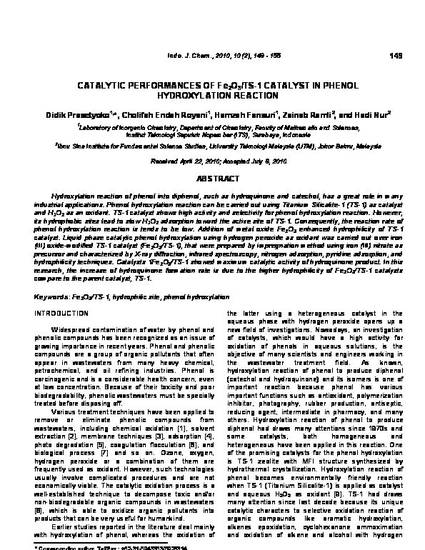
Article
Catalytic performance of Fe2O3/TS-1 catalyst in phenol hydroxylation
Indonesian Journal of Chemistry
(2010)
Abstract
Hydroxylation reaction of phenol into diphenol, such as hydroquinone and catechol, has a great role in many industrial applications. Phenol hydroxylation reaction can be carried out using Titanium Silicalite-1 (TS-1) as catalyst and H2O2 as an oxidant. TS-1 catalyst shows high activity and selectivity for phenol hydroxylation reaction. However, its hydrophobic sites lead to slow H2O2 adsorption toward the active site of TS-1. Consequently, the reaction rate of phenol hydroxylation reaction is tends to be low. Addition of metal oxide Fe2O3 enhanced hydrophilicity of TS-1 catalyst. Liquid phase catalytic phenol hydroxylation using hydrogen peroxide as oxidant was carried out over iron (III) oxide-modified TS-1 catalyst (Fe2O3/TS-1), that were prepared by impregnation method using iron (III) nitrate as precursor and characterized by X-ray diffraction, infrared spectroscopy, nitrogen adsorption, pyridine adsorption, and hydrophilicity techniques. Catalysts 1Fe2O3/TS-1 showed maximum catalytic activity of hydroquinone product. In this research, the increase of hydroquinone formation rate is due to the higher hydrophilicity of Fe2O3/TS-1 catalysts compare to the parent catalyst, TS-1.
Keywords
- Fe2O3/TS-1,
- hydrophilic site,
- phenol hydroxylation
Disciplines
Publication Date
2010
Citation Information
Didik Prasetyoko, Cholifah Endah Royani, Hamzah Fansuri, Zainab Ramli, et al.. "Catalytic performance of Fe2O3/TS-1 catalyst in phenol hydroxylation" Indonesian Journal of Chemistry Vol. 10 Iss. 2 (2010) p. 149 - 155 Available at: http://works.bepress.com/hadi_nur/119/
